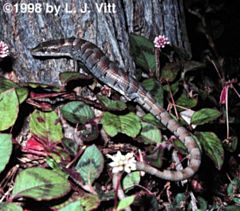Project 4941: S. G. Scarpetta, D. T. Ledesma, C. J. Bell. 2021. A new extinct species of alligator lizard (Squamata: Elgaria) and an expanded perspective on the osteology and phylogeny of Gerrhonotinae. BMC Ecology and Evolution. 21 (1):null.
Abstract
BackgroundAlligator lizards (Gerrhonotinae) are a well-known group of extant North American lizard. Although many fossils were previously referred to Gerrhonotinae, most of those fossils are isolated and fragmentary cranial elements that could not be placed in a precise phylogenetic context, and only a handful of known fossils are articulated skulls. The fossil record has provided limited information on the biogeography and phylogeny of Gerrhonotinae.Results
We redescribe a nearly complete articulated fossil skull from the Pliocene sediments of the Anza-Borrego Desert in southern California, and refer the specimen to the alligator lizard genus Elgaria. The fossil is a representative of a newly described species, Elgaria peludoverde. We created a morphological matrix to assess the phylogeny of alligator lizards and facilitate identifications of fossil gerrhonotines. The matrix contains a considerably expanded taxonomic sample relative to previous morphological studies of gerrhonotines, and we sampled two specimens for many species to partially account for intraspecific variation. Specimen-based phylogenetic analyses of our dataset using Bayesian inference and parsimony inferred that Elgaria peludoverde is part of crown Elgaria. The new species is potentially related to the extant species Elgaria kingii and Elgaria paucicarinata, but that relationship was not strongly supported, probably because of extensive variation among Elgaria. We explored several alternative biogeographic scenarios implied by the geographic and temporal occurrence of the new species and its potential phylogenetic placements.Conclusions
Elgaria peludoverde is the first described extinct species of Elgaria and provides new information on the biogeographic history and diversification of Elgaria. Our research expands the understanding of phylogenetic relationships and biogeography of alligator lizards and strengthens the foundation of future investigations. The osteological data and phylogenetic matrix that we provided will be critical for future efforts to place fossil gerrhonotines. Despite limited intraspecific sampled sizes, we encountered substantial variation among gerrhonotines, demonstrating the value of exploring patterns of variation for morphological phylogenetics and for the phylogenetic placement of fossils. Future osteological investigations on the species we examined and on species we did not examine will continue to augment our knowledge of patterns of variation in alligator lizards and aid in phylogenetics and fossil placement.
Read the article »
Article DOI: 10.1186/s12862-021-01912-8
Project DOI: 10.7934/P4941, http://dx.doi.org/10.7934/P4941
| This project contains |
|---|
Download Project SDD File |
Currently Viewing:
MorphoBank Project 4941
MorphoBank Project 4941
- Creation Date:
07 November 2023 - Publication Date:
07 November 2023
Authors' Institutions ![]()
- University of Texas at Austin

